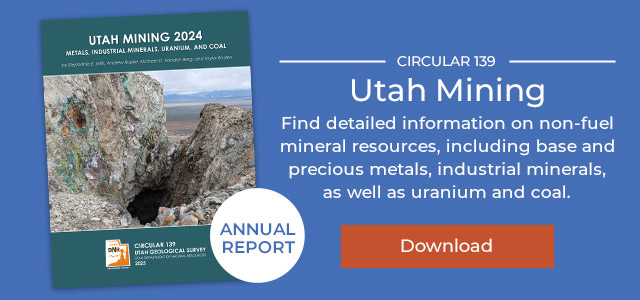Coalbed Methane
Utah’s production of coalbed methane began in 1951 northwest of Castle Dale on the west flank of the San Rafael Swell. Utah’s coalbed methane is produced mostly from the Ferron Sandstone Member of the Cretaceous-age Mancos Shale and the Blackhawk Formation, which also contain mineable resources of coal. In contrast to a conventional gas reservoir, where gas is found inside the pores of a material, coalbed methane is found stored in a near-liquid state on the surface of the coal or in natural fractures. Geology, organic maturity, and other variables contribute to the potential for gas exploration and economic production.
Frontier Areas for Coalbed-Gas Exploration
The remarkably successful development of gas deposits in coalbeds of the Ferron Sandstone Member of the Mancos Shale in central Utah’s Emery coalfield has encouraged petroleum companies to look for new coalbed-gas “plays” elsewhere in the state.
There are currently six frontier coalbed-gas plays in Utah attracting industry interest. These plays are in various stages of testing or development. The undeveloped portions of these six plays collectively contain an estimated in-place gas resource ranging from 2.0 to 9.8 trillion cubic feet (Tcf), which is significant compared to Utah’s 2001 proven gas resource of 4.6 Tcf.
Book Cliffs Play
The best-defined frontier coalbed-gas play consists of the thick, gassy coals of the Blackhawk Formation in the Book Cliffs coalfield.
Exploration began in the early 1970s, and a modest amount of coalbed-gas production took place during the 1990s. This play may be poised for full-scale development if current efforts can overcome the production problems that plagued the earlier efforts.
Although extensively mined, the Book Cliffs play contains about 70,000 acres underlain by deeper coal in the Blackhawk Formation where the aggregate coal thickness ranges from 10 to 70 feet, and drilling depths range from 1,500 to 6,000 feet. The coal’s gas content ranges from 60 to 435 cubic feet per ton, and thus provides a range of 0.8 to 1.9 trillion cubic feet (Tcf) of in-place gas resource.
Wasatch Plateau Play
Coalbeds in the Emery Sandstone Member of the Mancos Shale occur under the Wasatch Plateau of central Utah, and are not exposed at the surface. Extrapolating from a handful of oil and gas wells indicates these never-mined coals underlie about 180,000 acres of the Wasatch Plateau.
At least 17 coalbeds with a collective thickness of up to 120 feet occur within the 1,600-foot-thick Emery strata. No published gas-content measurements exist for these coals, but one company reports some beds are gassier than others. The in-place gas resource for this play is estimated to range from 0.8 to 3.2 Tcf.
Sego Play
The Neslen Formation coalbeds of the Sego coalfield are exposed along the Book Cliffs in Grand County. These coalbeds extend northward into the Uinta Basin along the Colorado-Utah state line, and underlie roughly 240,000 acres.
The Neslen Formation is up to 700 feet thick, and contains an average of 14 feet of coal in one to seven beds. While shallow core samples contained less than 49 cubic feet of gas per ton of coal, there are indications the deeper coals are gassier.
Alton-Kolob Play
In southern Utah, the Dakota Sandstone’s coalbeds are best developed in the Alton-Kolob coalfields.
The Dakota Sandstone is up to 450 feet thick and contains two coal zones. These two coal zones collectively contain up to 18 feet of coal, and have an average aggregate thickness of 13 feet. While the two reported measurements from shallow samples revealed low gas contents of 0 and 14 cubic feet per ton, this 400,000- acre play could contain nearly 1 Tcf of gas if the deeper coalbeds contain an average of 100 cubic feet per ton.
Johns Valley-Kaiparowits Plateau Play
The thick Straight Cliffs Formation coals have attracted some interest in the Johns Valley area and the northern part of the Kaiparowits Plateau coalfield in Garfield County, outside the Grand Staircase Escalante National Monument.
The 130,000-acre play contains an average aggregate thickness of 40 feet of coal within the 600- to 1,600-foot-thick John Henry Member of the Straight Cliffs Formation. A group of investors with large private holdings in the Johns Valley portion of the play is undertaking an evaluation of the coalbed gas potential on their lands.
While 13 shallow samples near the outcrop had low gas contents, they hope the deeper coalbeds contain at least 100 cubic feet of gas per ton. If so, this play could contain 0.9 Tcf of gas.








